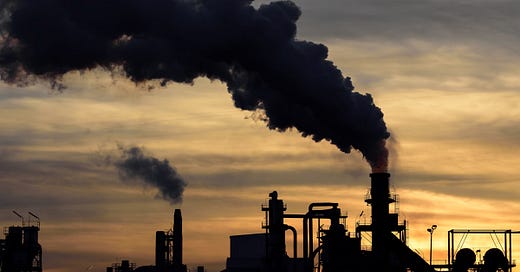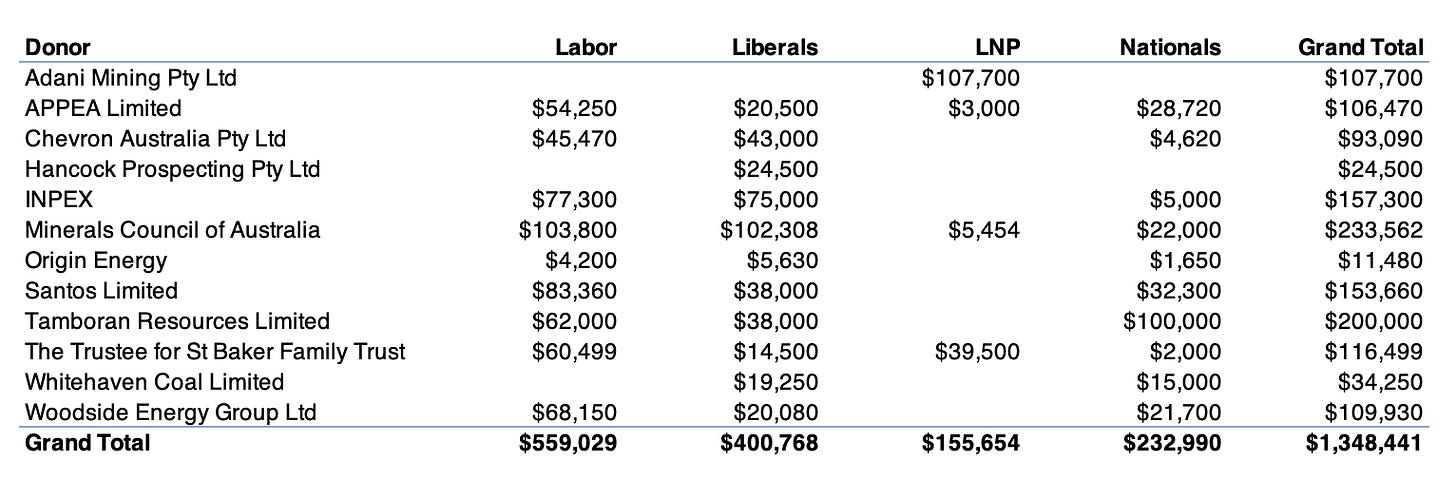Fossil fuels poured $1.3+ million into the major parties in 2022, but then the climate movement fought back
New data from the Electoral Commission shows how fossil fuel giants funded the election campaigns of the major parties in 2022. But, it also marked a financial fightback by the climate movement.
This is a bit of a special edition of tempests and terawatts as I do a deep dive into the freshly released political donation disclosure data published on Wednesday by the Australian Electoral Commission (AEC).
The start of February marks the day the AEC releases to the public details of the political donations made during the previous financial year. Today, we got to see the donations from the 2021-22 year for the first time.
Significantly, this includes the period leading up to the 2022 federal election.
As we’ve sadly come to expect, the data shows the major parties - being Labor, the Liberals and the Nationals - happily taking more funds from the fossil fuel industry.
The AEC’s data shows at least $1.35 million in fossil fuel money flowing to the major parties ahead of a federal election where the climate crisis was a top ranking factor for voters.
It shows how the money was evenly spread across the major parties, with Labor netting almost $600,000 and the Coalition receiving almost $790,000 across both the Liberals and Nationals.
I pulled together a summary of the individual donations made by fossil fuel groups in a Twitter thread, which you can check out here:

The list includes familiar names; Adani, Chevron, Santos, Whitehaven and Woodside, as well as lobby groups APPEA and the Minerals Council of Australia.
It is almost a mirror copy of fossil fuel donations that was published last year, which I wrote about at the time for RenewEconomy.
I’ll note that according to the AEC’s data, no fossil fuel money flowed to the Australian Greens, nor did any money flow to the group of ‘teal independents’, which both campaigned on a platform of stronger climate action.
We know this money buys influence. Companies don’t make political donations without knowing they will be getting something in return. These donations are merely a cost of doing business.
For these companies, political donations are often the price of admission to the private dinners and influential events that provide direct access to the ministers and shadow ministers hoping to shape Australia’s future climate and energy policies.
It is access the average voter does not enjoy, and historically, it is not access that groups campaigning for better access for the environment have been able to gain.
but then the climate movement fought back…
While the data shows the fossil fuel industry yet again pouring money into the major parties, the 2022 federal election marked a paradigm shift in the impact of money in politics and the power of grassroots movements.
Climate 200 is the fundraising project that was started by Simon Holmes à Court in an effort to counter the influence of corporate donors. According to the AEC’s latest data, Climate 200 raised almost $10 million in the lead-up to the 2022 federal election, amassing a war chest that was used to fund the campaigns of independent candidates committed to backing stronger climate action.
The disclosures show Climate 200’s funds came overwhelmingly from individuals, its largest backers being Atlassian co-founders Mike Cannon-Brookes and Scott Farquar. The duo chipped in more than $3.7 million between them. Another major backer was share market trader Rob Keldoulis who added a further $1.2 million.
But the majority of the funds came from more than 11,200 individual small donors.
As Holmes à Court has articulated, Climate 200 was an effort to combat the vast amount of corporate money (including from the fossil fuel industry) that powers the election campaigns of the major parties.
The great thing is that it worked. By coordinating the support of its grassroots backers, ten of the independent candidates supported by Climate 200 successfully won election to the House of Representatives. Former Wallabies captain David Pocock was also elected as a senator for the ACT.
It was an unprecedented outcome for a group that was largely made up of candidates entering politics for the first time, and defeating well-resourced major party incumbents.
In contrast, the donations disclosures show mining billionaire Clive Palmer spending more than $117 million on the election, but winning just a single senate seat for the climate-denying United Australia Party.
In 2022, grassroots climate action beat the fossil fuel industry.
But… we still don’t have the full picture
It’s important to note that what was released by the AEC today is a list of the political donations that met the AEC’s disclosure thresholds. Currently, the disclosure threshold stands at $14,500 - meaning only donations that exceed this amount need to be reported publicly.
As you can imagine, this means it is possible to donate a huge chunk of money and not have it disclosed publicly. The Centre For Public Integrity estimates that more than a third of money received by political parties is of unknown origin.
Additionally, we’ve had to wait until now to learn what donations were received by political parties ahead of the federal election held in May last year. Because of the way the rules are written, we’ve had to wait for more than seven months until after we had already cast our votes to learn how campaigns were funded.
We should be able to know this information before we vote.
Voters deserved to know that Adani funded the LNP’s campaign in Queensland. That the Nationals happily received donations from tobacco giant Philip Morris and that Labor took $62,000 from Tamboran Resources - a company fracking for gas in the Beetaloo Basin.
Thanks so much for reading!
The response to the first edition of tempests and terawatts last week exceeded my expectations, and certainty motivated me to do more. You can read ‘The Problematic Paradox of Carbon Offsets’ for free.
If you haven’t already, please subscribe to receive future editions of tempests and terawatts - sent each fortnight.






